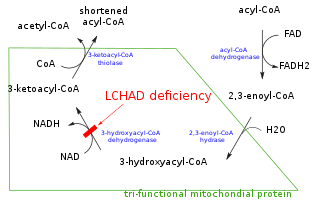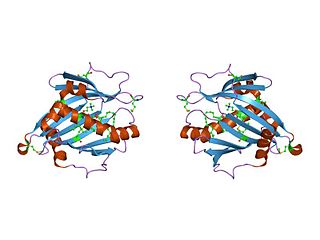
Amino acids are organic compounds that contain both amino and carboxylic acid functional groups. Although hundreds of amino acids exist in nature, by far the most important are the alpha-amino acids, which comprise proteins. Only 22 alpha amino acids appear in the genetic code.

In pharmacology, the fibrates are a class of amphipathic carboxylic acids and esters. They are derivatives of fibric acid. They are used for a range of metabolic disorders, mainly hypercholesterolemia, and are therefore hypolipidemic agents.
ATC code C10Lipid modifying agents is a therapeutic subgroup of the Anatomical Therapeutic Chemical Classification System, a system of alphanumeric codes developed by the World Health Organization (WHO) for the classification of drugs and other medical products. Subgroup C10 is part of the anatomical group C Cardiovascular system.

Zellweger syndrome is a rare congenital disorder characterized by the reduction or absence of functional peroxisomes in the cells of an individual. It is one of a family of disorders called Zellweger spectrum disorders which are leukodystrophies. Zellweger syndrome is named after Hans Zellweger (1909–1990), a Swiss-American pediatrician, a professor of pediatrics and genetics at the University of Iowa who researched this disorder.
Substances, mixtures and exposure circumstances in this list have been classified by the International Agency for Research on Cancer (IARC) as group 3: The agent is not classifiable as to its carcinogenicity to humans. This category is used most commonly for agents, mixtures and exposure circumstances for which the evidence of carcinogenicity is inadequate in humans and inadequate or limited in experimental animals. Exceptionally, agents (mixtures) for which the evidence of carcinogenicity is inadequate in humans but sufficient in experimental animals may be placed in this category when there is strong evidence that the mechanism of carcinogenicity in experimental animals does not operate in humans. Agents, mixtures and exposure circumstances that do not fall into any other group are also placed in this category.

In biochemistry and metabolism, beta-oxidation is the catabolic process by which fatty acid molecules are broken down in the cytosol in prokaryotes and in the mitochondria in eukaryotes to generate acetyl-CoA, which enters the citric acid cycle, and NADH and FADH2, which are co-enzymes used in the electron transport chain. It is named as such because the beta carbon of the fatty acid undergoes oxidation to a carbonyl group. Beta-oxidation is primarily facilitated by the mitochondrial trifunctional protein, an enzyme complex associated with the inner mitochondrial membrane, although very long chain fatty acids are oxidized in peroxisomes.

Fenofibrate, is an oral medication of the fibrate class used to treat abnormal blood lipid levels. It is less commonly used compared than statins because it treats a different type of cholesterol abnormality to statins. While statins have strong evidence for reducing heart disease and death, there is evidence to suggest that fenofibrate also reduces to the risk of heart disease and death. However, this seems only to apply to specific populations of people with elevated triglyceride levels and reduced high-density lipoprotein (HDL) cholesterol. Its use is recommended together with dietary changes.

Clofibric acid is a biologically active metabolite of the lipid-lowering drugs clofibrate, etofibrate and theofibrate with the molecular formula C10H11ClO3. It has been found in the environment following use of these drugs, for example in Swiss lakes and the North Sea.
Ronifibrate is a fibrate, a hypolipidemic agent. It is a combined ester of clofibric acid and niacin with 1,3-propanediol. In the body, the ester is split to 1,3-propanediol and both acids which work in the same way, lowering lipids in blood.
Simfibrate is a fibrate that has been used for the treatment of hyperlipidemia. The substance is a double ester of clofibric acid with 1,3-propanediol which is cleaved in the body to one molecule of 1,3-propanediol and two molecules of clofibric acid which is the true lipid-lowering agent.
Aluminium clofibrate is a fibrate.

PPAR agonists are drugs which act upon the peroxisome proliferator-activated receptor. They are used for the treatment of symptoms of the metabolic syndrome, mainly for lowering triglycerides and blood sugar.
The molecular formula C10H11ClO3 (molar mass: 214.64 g/mol, exact mass: 214.0397 u) may refer to:

Phosphatidylcholine transfer protein (PCTP) also known as StAR-related lipid transfer domain protein 2 (STARD2) is a specific intracellular phospholipid binding protein that can transfer phosphatidylcholine between different membranes in the cytosol.
Acefylline clofibrol is a derivative of acefylline and clofibrate used as a hypolipidemic agent.

Tibric acid is a sulfamylbenzoic acid that acts as a hypolipidemic agent. Although it was found to be more powerful than clofibrate in lowering lipid levels, it was found to cause liver cancer in mice and rats, and so was not introduced as a human drug. In rats it causes an increase in peroxisomes, and liver enlargement, and then liver cancer. However the peroxisome changes do not occur in humans, and it is not likely to cause liver cancer in humans.
The Coronary Drug Project (CDP) was a large clinical trial which assessed several different treatments for coronary heart disease in men with previous myocardial infarction. The study was conducted from 1965 to 1985 at 53 clinical centers and randomized 8,341 men age 30 to 64 years to six different treatment groups: low-dose estrogen therapy, high-dose estrogen therapy, clofibrate (1.8 g/day), dextrothyroxine (6 mg/day), niacin (3 g/day), and placebo.








